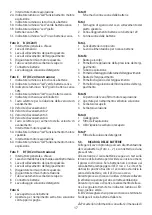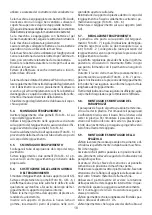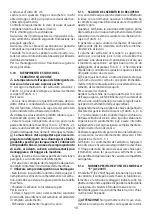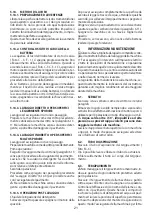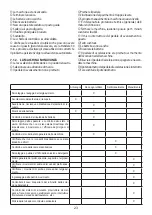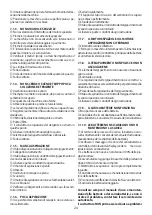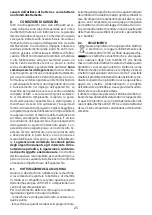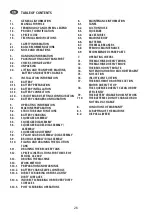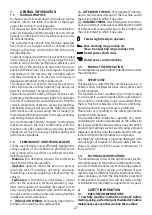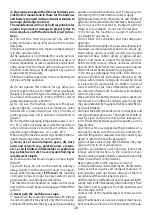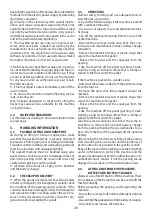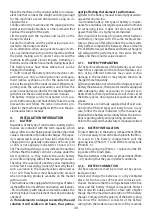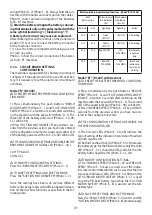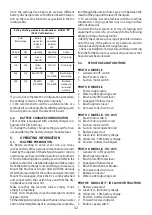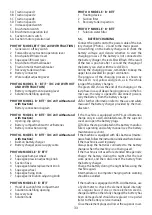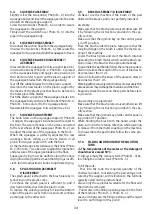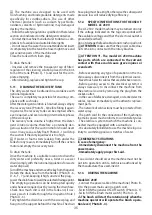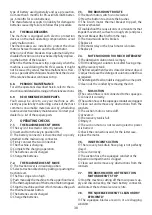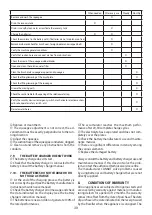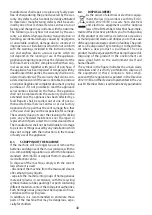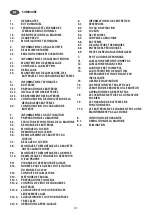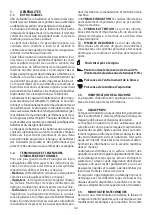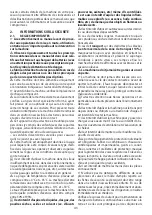
28
•
Rigorously comply with all the instructions pro-
vided in this manual and in those for the batteries
and battery chargers (with particular attention to
warnings and danger notices).
The manufacturer will not be held responsible for
injuries to persons or damage to property due to
non-compliance with the aforementioned instruc-
tions.
•
This machine must be powered only with the
safety extra-low voltage indicated on the technical
data plate.
☞
Before using the machine, make sure that each part
is in the correct position.
•
The appliance is not intended for use by persons
(including children) with reduced physical, sensory or
mental capabilities, or lack of experience and knowl-
edge, unless they have been given supervision or in-
struction concerning use of the appliance by a person
responsible for their safety.
Children should be supervised to ensure that they do
not play with the appliance.
•
Do not operate this machine for any other pur-
pose except for the use for which it was specifically
designed. Evaluate the type of building where it will
be utilized and rigorously comply with the current
safety regulations and conditions.
•
Do not use the machine in places without ad-
equate lighting, in explosive environments, when
harmful dirt is present (dust, gas, etc.), on roads or
public passageways and in outdoor environments in
general.
•
The machine operating temperature range is +4°C
to + 35°C; when not being used, store the machine in
a dry and non-corrosive environment within a tem-
perature range of b 10°C and + 50°C.
When using the machine under any condition the hu-
midity must range between 30% and 95%.
•
Never use or vacuum liquids, gases, dry dust,
acids and solvents (e.g. paint thinners, acetone,
etc.), even if diluted, inflammables or explosives
(e.g. petrol, fuel oil, etc.); never vacuum flaming or
incandescent objects.
•
Do not use the machine on slopes or ramps steeper
than 2%.
For small slopes, do not use the machine sideways,
always handle it with caution and never move back-
wards. When transporting (10% max) the machine
on steeper ramps or slopes, be very careful to avoid
tipping and/or uncontrolled accelerations.
The machine can be handled on ramps and/or steps
only with the brush head and squeegee lifted off the
ground.
•
Never park the machine on a slope.
☞
Never leave the machine unattended with the key
in and connected; it may be left only after having dis-
connected it and taken the key out and guaranteeing
against accidental movements and, if necessary, dis-
connecting it from the electrical power supply.
•
Make sure there are no other persons, and children in
particular, in the area where the machine is being used.
•
Do not use the machine to transport persons/
things or to tow objects. Do not tow the machine.
☞
Do not use the machine as a support surface for
any weight for any reason.
Do not block the ventilation and heat dispersion
openings.
•
Do not remove, modify or by-pass the safety devices.
•
Always use individual safety devices to ensure op-
erator safety: aprons or safety overalls, non-slip and
waterproof shoes, rubber gloves, goggles and ear-
phones, and masks to protect the respiratory tract.
Before starting to work, remove necklaces, watches,
ties and other objects that may cause serious injuries.
•
Do not insert hands between moving parts.
☞
Do not use detergents that differ from those re-
quired and follow the instructions indicated on the
relative safety sheets. Detergents should be stored
in a place that is inaccessible to children. In case of
contact with the eyes, rinse immediately with copi-
ous amounts of water and, if swallowed, immediately
consult a physician.
Make sure that the battery charger power sockets are
connected to an efficient earthing system and that
they are protected by magneto thermal and differen-
tial circuit breakers.
•
Follow the battery manufacturer’s instructions and
comply with legal provisions. The batteries should al-
ways be clean and dry to avoid surface leakage cur-
rents. Protect the batteries against impurities, such as
metallic dust.
•
If the machine is equipped with gel batteries it is
essential to make sure the run-down indicator (lo-
cated on the panel) is adjusted correctly. Contact your
dealer or refer to the specific paragraph.
•
Do not place tools on top of the batteries: they may
cause a short-circuit or an explosion.
•
When using battery acid, rigorously respect the
relative safety instructions. In the presence of par-
ticularly strong magnetic fields, evaluate the possible
effect on electronic control devices.
Never spray water on the machine to clean it.
☞
Recovered fluids contain detergents, disinfectants,
water, as well as organic and inorganic material col-
lected during work operations: dispose of them in
accordance with current legal provisions.
•
If the machine malfunctions and/or operates ineffi-
ciently, turn it off immediately (disconnecting it from
the electric power supply or from the batteries) and
do not tamper with it.
Contact one of the manufacturer’s technical service
centres.
•
All maintenance or accessory replacement opera-
tions must be carried out in environments with ade-
Summary of Contents for CPS 50 B
Page 3: ...3 2 1 3 A B 6 1 3 4 5 2 E AC 230V...
Page 4: ...4 C D 2 2A 3A 3B 3C 1A 1 3 6 3 4 5 1 8 2 B DC 24V 7...
Page 6: ...6 H G 1 2 1 3 2 I...
Page 7: ...7 1 2 L M 1 1 4 4 3 2 5 7 6 5 2 6...
Page 8: ...8 N O 1 1 2 3 3 2 4...
Page 9: ...9 P 1...
Page 91: ...91 1 1 1 1 2 2 10 1 3 1 4...
Page 92: ...92 1 5 2 2 1 4 35 10 50 30 95 2 10...
Page 93: ...93 2 2...
Page 94: ...94 3 3 1 3 2 3 3 C C 3 4...
Page 95: ...95 4 4 1 20 20 20h 5 5 5h 5 5 20 20 24 4 1 1 4 1 2 I 2 G 1 3 I 1 I 2...
Page 101: ...101 2 2 2 P 1 5 11 3 1 5 D 6 F 7 3 5 12 AC 230V AC230 AC 230V...
Page 103: ...103 5 14 5 14 1 5 14 2 3 1 3 1 5 14 3 6 13 5 14 4 6 13 6 14 3 5 14 5 6 11 6 6 1 50...
Page 104: ...104 6 2 M 3 6 3 6 4 6 5 6 6 6 7...
Page 105: ...105 6 8 6 8 1 6 8 2 6 8 3 6 9 7 7 1 1 C 7 2 5 7 3...
Page 106: ...106 7 4 7 5 7 6 7 7 7 8 7 9 7 10 100 20 30 8 12...
Page 107: ...107 8 1 2013 56 EU 8 2 2012 19 EU 2012 19 EU...
Page 124: ...124...
Page 125: ...125...
Page 126: ...126...
Page 127: ...127...
Page 128: ...128...
Page 129: ...129...
Page 130: ...130...
Page 131: ...131...
Page 238: ...238 1 1 1 1 2 2 10 1 3 a 1 4...
Page 239: ...239 1 5 2 2 1 4 C 35 C 10 C 50 C 30 95 2 10...
Page 240: ...240 2 2 3 3 1 3 2 3 3...
Page 241: ...241 3 4 4 4 1 Ah 20 C20 20h 5 C5 5h C5 C20...
Page 247: ...247 50 C N 4 N 3 2 N 2 2 L Q 1 5 11 N 3 0 1 B 6 D 6 F 7 0 3 5 12 230V 230V AC 230V...
Page 249: ...249 5 14 2 C 3 E 1 C 3C E 1C 5 14 3 6 13 5 14 4 6 13 6 14 3 5 14 5 6 11 6 6 1 50 6 2 3...
Page 250: ...6 3 250 6 4 6 5 X X X X X X X X X X X X X X X X X X...
Page 251: ...251 6 6 BPb 3 AGM 6 6 7 6 8 6 9 7 7 1 ON 7 2 5 7 3...
Page 252: ...252 7 4 7 5 7 6 7 7 7 8 7 9 7 10 100 20 30 8 12...
Page 253: ...253 8 1 2013 56 8 2 WEEE 2012 19 2012 19 EU...
Page 255: ...255 1 1 1 1 2 2 2 10 1 3 1 4...
Page 256: ...256 1 5 2 2 1 4 C 35 C 10 C 50 C 30 95 2 10...
Page 257: ...257 2 2 134 3 3 1 3 2 3 3...
Page 258: ...258 3 4 4 4 1 4 1 1 Ah 20 C20 20h 5 C5 5h C5 C20...
Page 263: ...263 5 4 M 6 6 M 3 5 5 M 6 5 6 6 5 M 4 M 6 M 4 M 6 6 4 5 7 7 2 45 M 2 M 7 5 8 5 9 1 cm 1 cm...
Page 264: ...264 5 10 50 C N 4 N 3 G 2 N 2 2 cm 5 11 N 3 1 B 6 D 6 F 7 3 5 12 E AC 230V E AC 230V...
Page 267: ...6 2 M 3 6 3 267 X X X X X X X X X X X X X X X X X X...
Page 268: ...268 6 4 6 5 6 6 3 AGM 6 6 7 6 8 6 9 7 7 1 7 1 1 1...
Page 269: ...269 30 7 1 2 5 7 1 3 7 1 4 7 1 5 7 1 6...
Page 270: ...270 7 1 7 7 1 8 7 1 9 7 1 10 100 20 30 8 12 8 1...
Page 271: ...271 2013 56 E 8 2 2012 19 2012 19...




